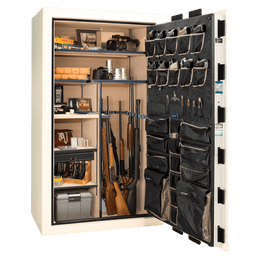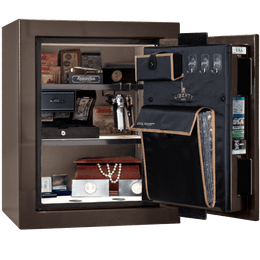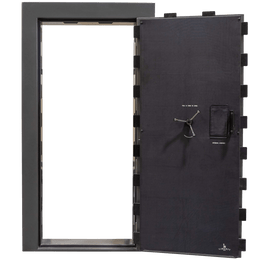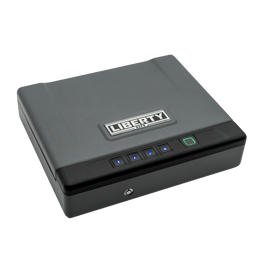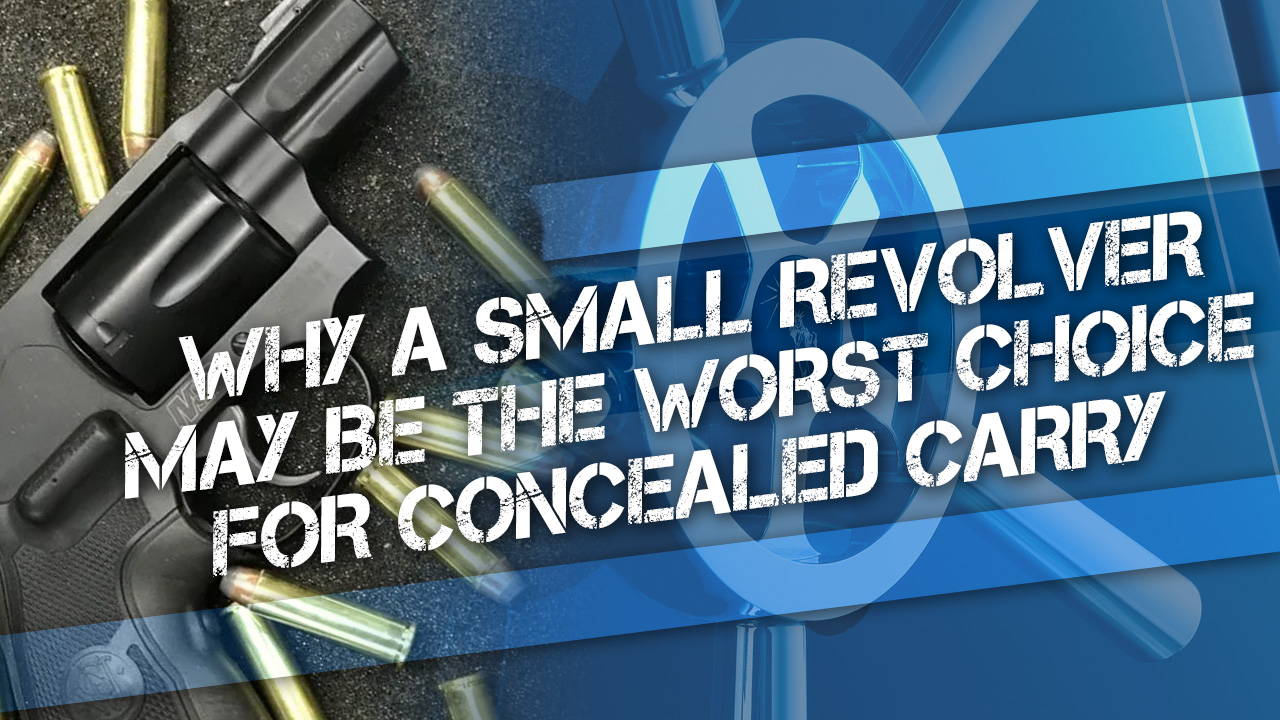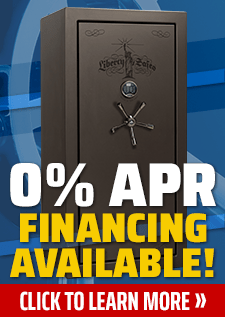For a long time, before the current craze of uber-tiny micro-compact 9-millimeter concealed carry pistols, a snub nose revolver was considered one of the only viable options for concealed carry, particularly pocket carry or deep concealment.
Although small semi-automatic pocket pistols from Browning/FN and others were hugely popular early in the 20th century, by later 20th-century standards these pistols had mostly fallen out of favor for serious use due to their supposedly inadequate calibers (.22LR, .25 ACP, .32 ACP, etc.), fiddly operating mechanisms, or reliability concerns.
Table of Contents
- A brief introduction to the “J-frame” concealed carry revolver.
- Pros/advantages of the small-framed revolver for concealed carry.
- Cons/downsides of a small revolver for concealed carry.
- Tips for minimizing the downsides of a small revolver for concealed carry.
- Keep your revolver secure from unauthorized access with a Liberty safe or handgun vault.
By the mid-20th century, lots of detectives, under-cover cops, and armed citizens chose to carry a small Colt or Smith & Wesson .38 Special revolver as their backup or even primary concealed carry firearm. That trend continues to this day, and other makers such as Ruger and Kimber have recently developed new models to try to win sales in the burgeoning concealed-carry market.
But despite the high sales numbers, or maybe even because of them, it’s worth asking the question:
Is a small-framed, lightweight revolver really a good choice for a CCW handgun, particularly for new, inexperienced, or infrequent shooters?
Let’s go over the history, pros, and cons of these popular wheelguns, and you might be surprised to learn the reasons why carrying one may not be right for you.
S&W Model 340 in .357 Magnum With Crimson Trace Laser Grips
A brief introduction to the J-frame concealed carry revolver
One of the hottest-selling product lines for Smith & Wesson for the past 70 years has been their J-frame revolver models, the first of which was the .38 Chiefs Special introduced in 1950 at a conference of police chiefs. (Note that Colt’s J-frames are larger, service-sized revolvers.) A 5-shot, double-action, 19.5-ounce revolver with a 2 inch (often called a snubby) barrel and a slim, round-butt gripframe, the Chiefs Special (later renamed the Model 36) became hugely popular with police and private-citizen carry, and many variations have been created since.
In 1951 S&W introduced the airweight Model 37, which was basically a Chiefs Special with aluminum, rather than steel frame, as well as an aluminum cylinder. The aluminum cylinder models proved problematic and have since been replaced with steel or titanium-cylindered revolvers weighing between around 11 to 15 ounces, depending on the materials used.
However, despite the proliferation of models featuring variations in materials (including exotic scandium alloy and polymer-framed options), in hammer configuration (exposed, shrouded, or internal/hammerless), barrel length, grip configuration/size, and sights, the most popular has always been the 2-inch round-butt models, with the aluminum alloy-framed hammerless options like the S&W models 340, 442, and 642 remaining the top choices for concealed carry.
J-frames have been offered in various calibers over the years, but S&W currently only offers SKUs in .22LR, .22 Magnum, .38 Special, and .357 Magnum (which can of course also safely fire .38 Special cartridges). Of these, only the .38 and .357 are considered by most people to be adequate cartridges for self-defense purposes.
Over the years Taurus, Rossi, Charter Arms, Ruger, and others have offered their own versions of the 5-shot .38/.357 caliber snubby, but Smith & Wesson always dominated the market and still does. For the purposes of this article, we’ll be using the alloy-framed, 2-inch S&W J-frame in .38/.357 as the primary topic of discussion.
So let’s talk first about what’s good about them, and then we’ll go over the not-so-good.
S&W Model 37 “Airweight” in .38 Special
Pros/advantages of the small-framed revolver for concealed carry
They are relatively small and powerful for their size
A J-frame packs a significant amount of firepower in a compact package, particularly when chambered in .357 Magnum.
They are extremely light
With empty weights of between 11.3 and 14.5 ounces, an alloy- or polymer-framed 5-shot .38/.357 revolver is about as light as you can get in a CCW firearm in an effective defensive caliber.
They conceal well and draw smoothly from a pocket
In particular, the shrouded-hammer or hammerless types have a smooth, snag-free shape, low-profile sights, rounded corners, and small, smooth, grips. The rounded bumps and gentle corners can print less when carried under clothing than a square-shaped semi-automatic’s more blocky slide or grips might.
They are simple to operate, load, and unload
Most of these types of revolvers have only one external control in addition to the trigger: a button, latch, or lever that opens the cylinder for loading and unloading. Otherwise, just point it in the direction of the bad guy, pull the trigger, and boom.
It’s also much easier for a newer or less-experienced shooter to ensure that a revolver is unloaded, compared to a semi-auto. With the revolver’s cylinder swung out to the side, it’s very clear when the chambers are loaded with cartridges or are unloaded for storage/cleaning.
They have a reputation for reliability
Lots of old school gun counter experts still opine that a revolver is the most reliable handgun you can buy. There are some potential problems that can arise (see below), but in general, a revolver can withstand a lot of neglect and abuse and still remain functional. Some people point out that with a small revolver, you can even shoot from inside a vest/coat pocket if necessary, typically without causing a malfunction.
It’s simple to remedy a dud/misfire
Proponents like to point out that with a revolver, it’s simpler and more intuitive to deal with a misfire/dud (when you get a click instead of a bang). With most semi-autos, you would initiate a “tap-rack-bang” malfunction clearance drill, where you strike the magazine firmly upward to ensure it’s fully seated and locked, rack the slide to eject the faulty round, and then reacquire your sights and press the trigger if there’s still a threat.
With a revolver, when you get a click on a loaded chamber, you simply press the trigger again, to cycle the cylinder to the next loaded chamber (assuming there is one).
Taurus M85 .38 Special Revolver - Stainless Steel Matte
Cons/downsides of a small revolver for concealed carry
The key point to be made here is that, though these small, light revolvers are great to carry, they can be extremely difficult, and even quite painful, to actually shoot. Which, after all, is kinda the point. Here are some of the key reasons why an airweight J-frame or similar small revolver might be a terrible choice for a CCW handgun, particularly for new or inexperienced shooters:
Recoil is painful and distracting
Various shooters we’ve worked with have described the recoil of a lightweight J-frame, particularly with .38 +P or .357 Magnum on board, as sharp, significant, unpleasant, distracting, and painful.
I’d rather smash my hand with a hammer.
I’m done shooting that thing. Do you want it?
It’s not surprising that with a loaded weight of less than 16 ounces, and no springy-reciprocating slides and fancy barrel-locking mechanisms to absorb or redirect the energy, the recoil of these pocket rockets makes them more than a handful, and more than most shooters can handle effectively.
With hot 158- or 180-grain .357 Magnum loads, you might literally feel like the gun blew up in your hand after the first shot.
The recent polymer-framed models from S&W, Ruger, and Taurus may make a little difference in felt recoil, but for recoil-shy or new shooters, even standard defensive cartridges can hurt so much that they don’t want to shoot the revolver again, let alone practice with it enough to become competent.
Colt says their new (reborn) Cobra model, a 2-inch 6-shot .38 special revolver, is ideal for concealed carry. This firearm was designed to meet the needs of new shooters and seasoned professionals alike. It's enjoyable to shoot, easy to carry.
Colt Cobra Revolver .38 Special
However, the larger frame, all-steel construction, and bulky (if comfortable) full-fingered rubber grips that help make the Cobra enjoyable to shoot, also make it too large and heavy (at a comparably porky 25 ounces unloaded) for most people to pocket carry comfortably.
What’s more, if you’re going to have to carry your handgun in a holster on your belt, many experts would argue you may as well go with a thinner, lighter semi-automatic pistol with double or even triple the ammunition capacity and arguably superior ballistic performance. Which brings us to our next point.
Performance of defensive cartridges from 2” barreled revolvers is often marginal
Ballistic testing in 10% ordnance gelatin has shown that many popular JHP defense bullets in .38 Special and even in .357 Magnum don’t achieve the FBI-recommended minimum penetration depth of 12-inch, and many others don’t expand at all and thus overpenetrate beyond the 18-inch maximum recommended depth, when fired out of revolvers with 2-inch barrels.
Additionally, since many .38 Special and .357 Magnum loadings were designed with 4-inch or longer barrels in mind, they may give marginal performance out of 2-inch snubbies. Military Arms Channel found that a .38 +P cartridge fired from a 2-inch barreled Airweight produced a staggering 32% lower muzzle velocity and energy (789 feet per second, 172 foot-lbs) than that produced by a 9mm revolver (1163 fps, 372 ft/lbs) with effectively the same bullet weight and barrel length.
Even the mighty .357 magnum chronographed 6% lower velocities and energy (1090 fps, 329 ft/lbs) in the same bullet weight from effectively the same barrel length as the 9mm revolver, while producing much more (painful) recoil and muzzle blast.
(9mm revolvers are comparatively rare and expensive, and most require the use of moon clips for reliable ejection.)
If you choose .38 Special wadcutters, an oft-recommended cartridge for lower recoil use in these lightweight revolvers, you may indeed experience less discomfort when plinking or practicing, but terminal ballistic performance of these projectiles on a determined threat is debatable, and velocity and energy are very low by defensive standards.
Revolvers are thick and can be difficult to conceal
We said above in the pros section that the smooth, rounded shapes of revolvers can help them conceal better in some situations than similar-sized autos. However, you can’t get around the fact that revolvers are thick. The thinnest 5-shot revolver’s cylinder is wider, at 1.3” or more, than the overall width of nearly every pocket capable semi-automatic pistol.
If you carry IWB (inside the waistband) you’re going to notice that thickness. Even if you pocket carry, that bulky cylinder might stand out like a sore thumb, depending on your choice of clothing and pocket holster.
Concealable revolver grips are small and can be slippery
For decades, you could get J-frame revolver grips from S&W made out of any material you wanted, as long as it was wood. Most shooters found them too small and narrow to be useful, and too slippery to afford effective recoil control.
Nowadays rubber grips have become de rigueur on CCW revolvers, and, due to the painful recoil factor discussed above, some grips offered on these tiny revolvers have become bloated to the point of ridiculousness. If you have to strap a large, bulky, padded grip to your small, concealable revolver to make it tolerable to shoot, suddenly it’s not quite so small and concealable anymore.
Even small-handed shooters may find that the standard, concealable round-butt grips don’t offer enough to hold onto.
Ammunition capacity is limited
Even the smallest 9mm semi-auto pistol has a magazine capacity of 6 rounds. In .38 Special/.357 Magnum, the small revolvers we’re outlining here have a cylinder capacity of 5 rounds. You can get 6 or even 8 shots if you drop to smaller calibers like .32 or .22LR, but they typically don’t perform well in defensive applications.
Small revolvers are difficult to reload quickly (and may not extract fully)
As a follow-up to the point above, not only are revolvers lower in capacity than their contemporaries in the CCW semi-auto world, but they are also slower and more difficult to reload. The practical necessity for reloading during a real-world gunfight is very unlikely, but the fact remains that the process is much more fiddly with a revolver.
In the first place, these short-barreled revolvers have, by the necessity of their design, short ejection rods. In many cases the stroke of the ejector star is thus insufficient to fully extract empty cases from the chambers, particularly if the cases are hot, dirty, or have expanded significantly due to firing. Under stress, many shooters find they have to resort to picking the empty cases out of the chambers with their fingers.
As for reloading, you can use speedloaders that hold your cartridges in a circular housing ready to insert into the cylinder, or you can use speed strips that hold your cartridges by the rims in a polymer clip-like doohickey, or you can go old-school and fumble loose cartridges into the chambers one at a time.
Either way, lining up the bullet noses with 5 chambers on a revolver is nowhere near as simple as slamming a full magazine into the grip of a semi-automatic.
These revolvers have poor sights and a short sight radius
Compared to similar-sized semi-autos, J-frames and similar revolvers have a very short sight radius, or the distance between the rear and front sights. A longer sight radius usually means a more accurate sight picture.
Furthermore, to ease a carry revolver’s egress from a pocket or purse, most of them have very basic, flush-mounted rear sights and simple ramp front posts, with no provision for changing out the sights for more visible ones. (Unless you involve a gunsmith.)
Most small revolvers have heavy, long triggers and are difficult to shoot quickly and accurately
The lightweight that makes these revolvers a joy to carry, combined with a heavy and long trigger pull of up to 12 lbs or more, makes them particularly difficult to shoot well without good hand strength and a lot of regular practice.
Think about it this way: if the gun itself weighs less than 1 pound, and it takes 8, 10, or even 12 pounds of pressure to move the trigger to the rear (and that trigger stroke is much longer than on a semi-automatic), it’s much easier for the front sight to stray off the target as you stroke the trigger through its travel.
Some smaller shooters may feel the trigger is impossible to use at first blush, and have a hard time believing how much pressure they have to exert to make the gunfire.
This, combined with the sharp, even painful recoil mentioned above, places the small revolver in the expert category of CCW guns, rather than, as many people believe, the novice category.
It’s difficult to clear certain types of revolver malfunctions
We mentioned above the inadequate ejection stroke that can leave empty cases partially expelled from your snubby revolver’s chamber. But things can get much worse.
Many shooters who swear they’ve never had a malfunction with their revolvers have likely not shot a lot, because it’s relatively common for an oft-used revolver to get a grain or two of unburned powder or other debris under the ejector star at the back of the cylinder, which can lock up the gun and prevent the chamber from being opened without tools.
A stuck case in one or more chambers can cause the ejector star to jump the rim, resulting in an infuriating malfunction that prevents the chamber from closing and, you guessed it, requires the use of tools (and often a lot of cussing).
A third type of malfunction can occur in these super-light, sharp-recoiling revolvers, where a bullet can actually be pulled forward out of its case by the recoil (similar to a hammer-type bullet puller) and bind up the cylinder. This is uncommon with quality, well-crimped defensive ammo, but it is possible, and it causes a nasty situation that, again, requires the careful use of tools.
Unless something breaks, the vast majority of semi-automatic malfunctions can be remedied by tap-rack drills, or in the case of a double feed, an unload/reload drill.
Tips for minimizing the downsides of a small revolver for concealed carry
If you have determined that you want to choose a J-frame type revolver for your CCW gun, or if it’s the only gun you have access to, it’s a good idea to do everything you can to make the experience as pleasant as possible. Here are some points to thing about:
Consider steel or polymer frames
As noted above, a steel-framed revolver is heavier, but felt recoil can be significantly less. Additionally, the newer polymer-framed revolvers offered by several manufacturers often transmit less felt recoil to the shooter.
Choose your ammo carefully
It’s important to select ammunition that will likely perform as you intend it to in a defensive shooting. Look at ballistic gel tests and read reports of your selected ammunition, and try to find a load that shoots to point of aim, performs well in ballistic testing, and doesn’t produce punishing recoil or muzzle blast. Then buy as much of it as you can find/afford.
Use good grips that fit your individual hand
As noted earlier, the slick and thin wood grips that come on some small revolvers can make shooting more painful and difficult that it has to be. While the Ruger LCR and the new Colt Cobra come with large, cushy-rubber full-sized grips, they’re more difficult to conceal as a result.
You might like to practice with a comfortable grip and then install a smaller grip for carry, but be sure to practice enough with your actual carry setup to become proficient.
Rubber boot grips that end flush with the bottom of the gripframe may offer the best compromise between concealability, size, and shootability. Also, some grips such as Crimson Trace and others offer a laser to help with aiming in low-light conditions or unconventional shooting positions.
Optimize your sights
Many models just have plain notch-and-post iron sights. These can be improved with the judicious application of some high-visibility paint to the front sight. Fiber-optic rods and tritium-enhanced big dot options may be available for some models, so look into those, or consider talking to a gunsmith.
S&W’s recent Bodyguard polymer-framed revolvers come with the facility for optional, integrated laser aiming devices if desired.
Keep it clean
You should keep ANY firearm you intend to use for defensive purposes clean, maintained, and lubricated (and refresh the ammunition occasionally). Dirt and corrosion can not only damage the finish and bore of your revolver, but can cause malfunctions (like the dirt under the extractor star situation we went over above).
Pocket carry in particular can result in a surprising amount of lint, dust, and debris entering the mechanism of your revolver. Check it regularly, clean it often, and you’ll have less chance of a malfunction when you need your gun most.
Practice regularly
Ammo is pricey, rage access can be limited, and time is a precious resource. But if you intend to carry a handgun for protection, it’s your responsibility to become proficient with it. Practice as often as you can in order to maintain and improve your skills. Make it a priority.
Install lighter springs and/or polish the internal sliding surfaces (gunsmith recommended)
The heavy trigger pull of many CCW revolvers causes a lot of people to seek a remedy, perhaps with lighter mainspring and/or a good polish of the sliding surfaces inside the gun.
This can be a good idea in some cases, but be very careful. If you lighten the trigger pull too much, you can hurt reliability as the hammer may no longer have sufficient force to set off primers reliably.
Furthermore, don’t go sanding/filing/polishing anything inside your gun without training. We recommend you take your gun to a qualified gunsmith that understands how to do a good &ldq>uo;trigger job” for a CCW gun.
Keep your revolver secure from unauthorized access with a Liberty safe or handgun vault
Whatever CCW handgun you select, it’s your responsibility to keep it secure, either on your person or locked away from unauthorized hands. Liberty makes the best line of USA-made gun safes and handgun vaults for you and your family.
*Made in the U.S.A. from U.S. and Global Parts.


